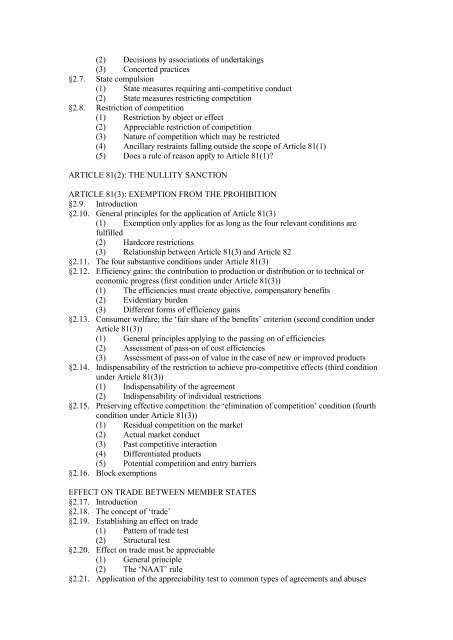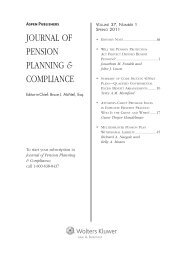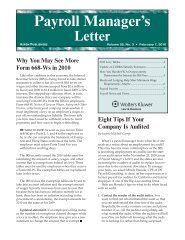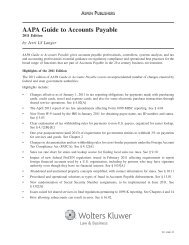TABLE OF CONTENTS - Van Bael & Bellis
TABLE OF CONTENTS - Van Bael & Bellis
TABLE OF CONTENTS - Van Bael & Bellis
You also want an ePaper? Increase the reach of your titles
YUMPU automatically turns print PDFs into web optimized ePapers that Google loves.
(2) Decisions by associations of undertakings<br />
(3) Concerted practices<br />
§2.7. State compulsion<br />
(1) State measures requiring anti-competitive conduct<br />
(2) State measures restricting competition<br />
§2.8. Restriction of competition<br />
(1) Restriction by object or effect<br />
(2) Appreciable restriction of competition<br />
(3) Nature of competition which may be restricted<br />
(4) Ancillary restraints falling outside the scope of Article 81(1)<br />
(5) Does a rule of reason apply to Article 81(1)?<br />
ARTICLE 81(2): THE NULLITY SANCTION<br />
ARTICLE 81(3): EXEMPTION FROM THE PROHIBITION<br />
§2.9. Introduction<br />
§2.10. General principles for the application of Article 81(3)<br />
(1) Exemption only applies for as long as the four relevant conditions are<br />
fulfilled<br />
(2) Hardcore restrictions<br />
(3) Relationship between Article 81(3) and Article 82<br />
§2.11. The four substantive conditions under Article 81(3)<br />
§2.12. Efficiency gains: the contribution to production or distribution or to technical or<br />
economic progress (first condition under Article 81(3))<br />
(1) The efficiencies must create objective, compensatory benefits<br />
(2) Evidentiary burden<br />
(3) Different forms of efficiency gains<br />
§2.13. Consumer welfare: the ‘fair share of the benefits’ criterion (second condition under<br />
Article 81(3))<br />
(1) General principles applying to the passing on of efficiencies<br />
(2) Assessment of pass-on of cost efficiencies<br />
(3) Assessment of pass-on of value in the case of new or improved products<br />
§2.14. Indispensability of the restriction to achieve pro-competitive effects (third condition<br />
under Article 81(3))<br />
(1) Indispensability of the agreement<br />
(2) Indispensability of individual restrictions<br />
§2.15. Preserving effective competition: the ‘elimination of competition’ condition (fourth<br />
condition under Article 81(3))<br />
(1) Residual competition on the market<br />
(2) Actual market conduct<br />
(3) Past competitive interaction<br />
(4) Differentiated products<br />
(5) Potential competition and entry barriers<br />
§2.16. Block exemptions<br />
EFFECT ON TRADE BETWEEN MEMBER STATES<br />
§2.17. Introduction<br />
§2.18. The concept of ‘trade’<br />
§2.19. Establishing an effect on trade<br />
(1) Pattern of trade test<br />
(2) Structural test<br />
§2.20. Effect on trade must be appreciable<br />
(1) General principle<br />
(2) The ‘NAAT’ rule<br />
§2.21. Application of the appreciability test to common types of agreements and abuses






